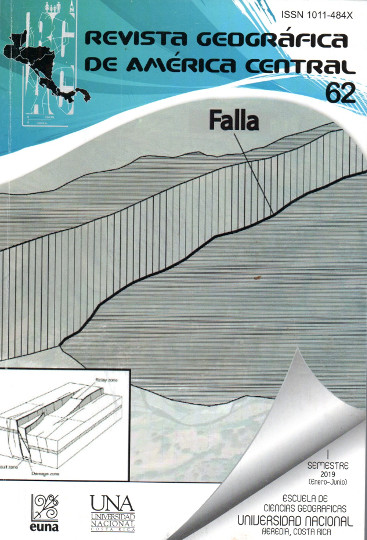Communal Territory: Local Agreements for Forest Exploitation in the Indigenous Community of San Juan Pamatácuaro, Mexico
DOI:
https://doi.org/10.15359/rgac.62-1.9Keywords:
Community territory, temperate forest, local agreements, normative system of uses and customs.Abstract
This article discusses the local agreements that rule and regulate the exploitation of forests in the indigenous community of San Juan Pamatacuaro, state of Michoacan, Mexico. This community enjoys a territory practically covered of a temperate forest, which is divided into two extensions: the plots of land and the area of common use. It is worth mentioning that there are few spaces intended for agricultural use. Community members have the right to a plot for the extraction of timber and so to earn income for the sustenance of the family: this is part of the agreements that make up from a normative system of uses and customs that determine the organization of the territory and the community in aspects such as family, timber work, productive projects, among others. The field work and observations from conceptual framework strengthened the analysis and development of research.
References
Altschuler, B. (2008). Repensando el desarrollo. Aportes y limitaciones del desarrollo local y la economía social a una estrategia de desarrollo. En Martínez Valle, Luciano (Compilador) Territorio en mutación: repensando el desarrollo desde lo local, (pp. 29-46) Ecuador: FLACSO. Recuperado de http://www.flacsoandes.edu.ec/libros?avanzado=0&query=Territorios+en+mutaci%C3%B3n%3A+Repensando+el+desarrollo++desde+lo+local+
Amerlinck, M. J. y Bontempo, F. (1994). El entorno construido y la antropología. Introducción a su estudio interdisciplinar, México: CIESAS.
Cancian, F. (1976). Economía y prestigio en una comunidad maya: el sistema religioso de cargos en Zinacantán, Celia Paschero (trad.), México: INI/SEP,
Cantero, P., Escalera, J., García del Villar, R. y Hernández, M. (2001). Territorio, sociabilidad y valor patrimonial del espacio urbano. Usos sociales del espacio público en el casco histórico de Sevilla. Recuperado de http://www.euskomedia.org/PDFAnlt/zainak/19/19125140.pdf
Cernea, M. (1995). Primero la gente. Variables sociológicas en el desarrollo rural, México: FCE.
Diario Oficial de la Federación. (1999). Ley Agraria, México: Diario Oficial.
Diario Oficial de la Federación. (2003). Ley General de Desarrollo Forestal Sustentable, México.
Elster, J. (1995). Tuercas y tornillos. Una introducción de las ciencias sociales, Traducción, Antonio Bonano, Barcelona: Gedisa,
Garibay, C. (2005). La transformación del comunalismo forestal: Identidad comunitaria, empresa social y poder corporado en el México contemporáneo, (Tesis de Doctorado en Antropología Social), Guadalajara: CIESAS Occidente.
Franco, M. (1997). La ley y la costumbre en la cañada de los once pueblos, El Colegio de Michoacán, A.C. Zamora Michoacán
Manzano, B. (2013). Territorios: teoría y disputas por el desarrollo local, pp.116-133). Recuperado de http://www.cedem.uh.cu/sites/default/files/116-133.pdf
Lefebvre, H. (1974). La producción del espacio. En Revista de sociología. 3 219‐229. Recuperado de https://crucecontemporaneo.files.wordpress.com/2011/11/1c2ba-47404221-lefebvre-henri-la-produccion-del-espacio.pdf
Jiménez, L. (Dir.) (2011). Patrimonio natural, cultural y paisajístico. Claves para la sostenibilidad territorial. España: Universidad de Alcalá. Recuperado de http://www.upv.es/contenidos/CAMUNISO/info/U0556177.pdf
Korsbaek, L. (1996). Introducción al sistema de cargos, Toluca, Edo. de México: UAEM.
Leff, E. (1998). Saber ambiental: sustentabilidad, racionalidad, complejidad, poder, México: Siglo XXI
Leff, E. (1995). Sobre la apropiación social de la naturaleza. En López Ramírez, Alfonso y Fernández, Pedro (coords.), Sociedad y medio ambiente: Contribuciones a la sociología ambiental en América Latina, Asociación Latinoamericana de Sociología, Universidad de Puebla, México.
Martín, A. (2001). Procesos de lucha y arreglos institucionales. El manejo forestal en la reserva de la biosfera mariposa monarca, (Tesis de Maestría, El Colegio de Michoacán), Zamora, Michoacán.
Olson, M. (1998). La lógica de la acción colectiva, México: Limusa-noriega.
Ostrom, E. (2000). El gobierno de los bienes comunes: la evolución de las instituciones de acción colectiva, México: CRIM/EFE/UNAM
Rodríguez, R. y Saavedra de la Cruz, G. (2012). La participación social en el ordenamiento territorial. Participación o representación un dilema legal y metodológico. En Aguilar Robledo, Miguel, et al., Ordenamiento territorial y participación social: problemas y posibilidades, México: INECC. 53-65. Recuperado de http://www.redalyc.org/articulo.oa?id=169419796004
Samper, M. (2013). Construyendo territorios participativos: sistematización de experiencias de desarrollo rural territorial en el centro de América, Costa Rica: ACIDCAC/IICA.
Santos, M. (2000). La naturaleza del espacio. Técnica y tiempo. Razón y emoción. México: Ariel, Recuperado de https://geografiacriticaecuador.files.wordpress.com/2013/01/santos-la-naturaleza-del-espacio.pdf
Secretaría de Recursos Hidráulicos (1986). Ley Forestal, México: Congreso de la Unión.
Tomadoni, C. (2007). A propósito de las nociones del espacio y territorio. En Gestión y Ambiente.10(1)
The Natural Conservancy (2007). Convention on biological diversity, Recuperado de https://www.cbd.int/protected-old/gap.shtml
Downloads
Published
How to Cite
Issue
Section
License
Proposed policy for journals offering Open Access
Authors publishing their works in the Journal acknowledge and agree to the following terms:
a) Authors retain the copyrights to their works and guarantee the Journal the right to be the first to publish their works, under the Creative Commons License Attribution-NonCommercial-ShareAlike 4.0 International, CC BY-NC-SA 4.0 International (https://creativecommons.org/licenses/by-nc-sa/4.0/deed.es), which allows others to share works upon complying with the acknowledgment of authorship and mention of the Journal as the original publisher of the work.
b) Authors are permitted to separately establish additional agreements for the non-exclusive distribution of the official edition of the work published in the Journal (for example, authors may desire to place the work in an institutional repository or incorporate it into a book that is to published elsewhere) so long they acknowledgment to recognize the Journal as the original publisher. The aforementioned additional agreements must respect the terms of the non-profit character and sharing philosophy of the original license (CC BY-NC-SA 4.0 International, https://creativecommons.org/licenses/by-nc-sa/4.0/deed.es).
c) Authors are encouraged to archive the post-print or editor/PDF version in Open Access repositories.






 REVGEO is licensed under https://creativecommons.org/licenses/by-nc-sa/4.0/deed.es
REVGEO is licensed under https://creativecommons.org/licenses/by-nc-sa/4.0/deed.es
.svg_4.png)

_(1).png)
_(1)_(1)_(1)_1.png)
(2)(1)(1)(1).png)
